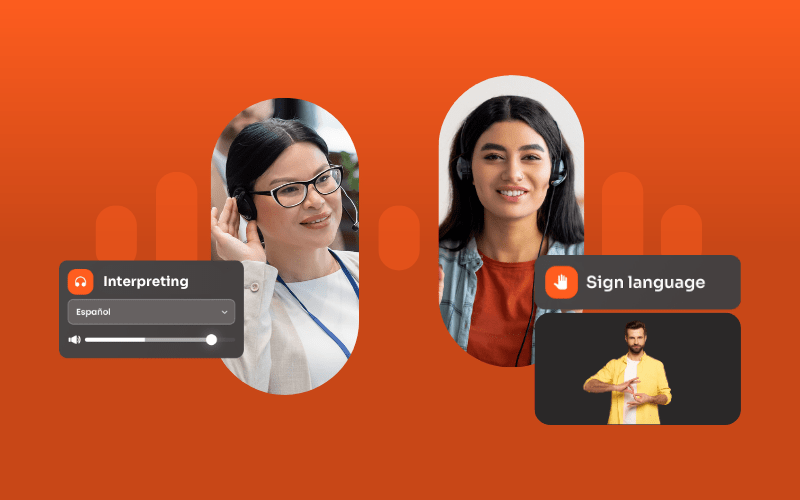Interpretation is the art of transforming a message from one language to another, either through speaking or signing. Unlike translation, which involves written communication, interpretation is done verbally or through sign language. This crucial distinction between the two is what sets them apart.
Depending on where you check you can find different classifications of types of interpretation. In this article, we will discuss types of interpretation based on the way the interpretation is performed and the modes or mediums through which it is delivered.
→ Related article: Interpretation vs translation - Do you know the difference?
Types of interpretation
Simultaneous interpretation
In this mode of interpretation, the interpreter delivers the message in the target language in real-time, at the same time as the speaker is still talking.
Simultaneous interpreting is a very challenging mode of interpretation as the interpreter must listen to a speech in one language, make sense of it in their head and deliver it in another language, in real-time and while the speaker talks. This is the mode of interpretation that is used in large-scale conferences, governmental meetings or any other meeting or event where the duration and flow of the meeting are important factors.
In traditional simultaneous interpretation setups, interpreters work from an interpreting booth where they get a view of the room, wear a headset and interpret into a microphone. They work in pairs and interpret for intervals of 20-30 minutes.
Consecutive interpretation
This type of interpretation requires the interpreter to wait for the speaker to finish their speech or statement before proceeding to deliver that same message in the target language. Since the interpreter has to wait for the speaker to finish talking, they usually take notes to remember what’s being said and later use them to deliver the interpretation.
Some scenarios where consecutive interpretation is used are official statements and diplomatic visits.
Bilateral interpretation
This is the type of consecutive interpretation done when two parties who don’t speak the same language meet. In it, the interpreter relays the message after the speaker has paused or finished speaking in each language in turns so that the conversation between the parties can happen. Situations, where bilateral interpretation is used, include doctor appointments, business meetings, negotiations, court hearings, or police interviews.
Sign language interpretation
Sign language interpretation is a vital tool that translates spoken or written language into visual communication through the use of gestures and facial expressions. This enables individuals who are deaf or hard of hearing to participate fully in various settings, including education, law, medicine, and social interactions. Sign language interpreters are critical in fostering inclusivity and accessibility for the deaf community. Their work requires expertise not only in sign language and its grammar but also in cultural sensitivity and understanding the unique needs of deaf individuals.
Sign languages vary based on spoken languages and are associated with specific countries or regions. American Sign Language (ASL) and British Sign Language (BSL) are widely used, while others are less known. Knowing one sign language does not necessarily mean understanding another.
Modes of interpretation
Whispered interpretation or chuchotage
This is the case when the interpreter whispers the message in the target language while the speaker is talking, to a small audience of maximum of four people. For this, the interpreter needs to be located close to the audience and this is typically done in small meetings and settings.
In-person interpretation
In-person interpretation takes place when the interpreter is physically present at the event. For simultaneous interpretation, the interpreters work in pairs from interpreting booths equipped with microphones, headsets, and an interpreting console that allows them to choose the language they listen to, mute themselves, and more. Attendees can listen to the interpretation using traditional radio receivers, or specialized mobile apps. This mode is typically used for large conferences, governmental meetings, or any other event where the duration and flow of the meeting are crucial.
→ Related article: Cost comparison: in-person interpretation vs remote interpretation
Over-the-phone interpretation (OPI interpretation)
This mode of interpretation allows two people who don’t speak the same language to connect using an interpreter over the phone. This kind of interpreting is usually done consecutively so, the interpreter lets one party speak, then relays the message in the other language. When the interpreter finishes, the other party responds and when they’re done, the interpreter renders the message into the first speaker’s language.
OPI typically occurs when there is no interpreter available on-site or when the two parties wanting to communicate are in different locations. Some settings where this is used are health care, government, financial or emergency telephone call centres.
Remote interpretation
In this mode of interpretation, the interpreter is not located on-site. Depending on the type of interpretation and systems used, we can distinguish between Video Remote interpretation and Remote Simultaneous Interpretation.
-
Video Remote interpretation (VRI):
Typically done using a web camera or videophone system to provide sign language or spoken language interpretation services between two parties who can’t otherwise communicate. The most common type of interpretation used in this mode is consecutive as the interpreter has to wait for the speaker to finish before conveying the message. Used when the interpreter in the language needed is not available on-site, or when a user with a hearing impairment needs to communicate with someone in a different location. Some settings where VRI is used include health care, social services, police, government or financial services.
-
Remote simultaneous interpretation (RSI):
The newest addition to the remote interpretation family, Remote Simultaneous Interpretation was born in 2014 with Interprefy producing the first-ever remote simultaneous interpretation platform. In this interpreting mode, interpreters can work from anywhere in the world if they have a laptop or desktop and a stable internet connection. They log into an interpreting soft console in the cloud and work in pairs, just as they would if they were in an interpreting booth.
RSI offers a range of benefits, including excellent flexibility as it can be used in remote, in-person or hybrid settings. It's typically used in events, conferences, webinars, business meetings, etc and users can listen to interpretation using their mobile phones, laptops, desktops or traditional radio receivers.
AI interpretation
Usually referred to as AI speech translation, this AI-powered mode provides a real-time rendition of the message using AI. It can be used in in-person, online, or hybrid settings as the AI can be delivered to any scenario that features the right technological setup. For meetings of up to 30 people that take place in person and that lack microphones, event-like technology setups, or that are on the move, Interprefy is the only provider that offers a solution directly on the attendee's mobile phone: Interprefy Now.
Different technologies work together to deliver real-time speech translation of the original message, including automatic speech recognition, text-to-speech, and machine translation. The result is different from what interpreters do, but it is also cheaper, so it's a good option for those cases where professional interpretation is out of scope for budget reasons.
→ Related article: Interpreters vs AI - the key differences
Conclusion
As we’ve seen, the types and modes of interpretation can be combined to better meet the needs of both the users and organisers and the meeting settings. Understanding the differences between each mode and type is crucial to choosing the solution that better meets your event and meeting requirements.

Not sure which interpretation type you need?
Recommended articles:
How does remote simultaneous interpretation work?
What are the benefits of remote simultaneous interpretation?
How much does remote simultaneous interpretation cost?




 More download links
More download links



